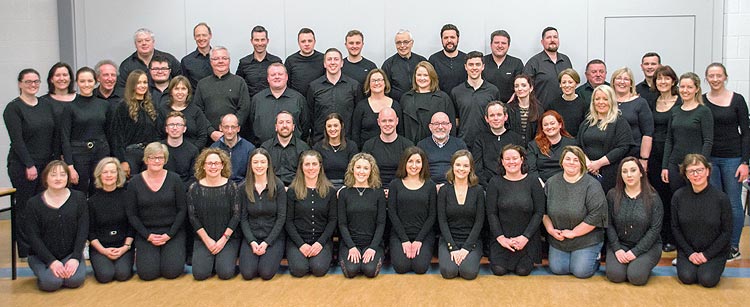P.R.O. & Vice Chairman of Thurles Musical Society, Mr Noel Dundon, reports:-

Even within the comparatively small community of Thurles Musical Society, the story of Michael Collins; the Treaty; the War of Independence and Eamon de Valera still resonates.
We could hardly have chosen a better year to stage a musical about his life and times given that the centenary of the Sologheadbeg incident, which kick- started the Irish War of Independence, commemorated just a few weeks ago just a few miles from our Cathedral Town.
The spotlight has certainly been cast upon the exigencies of those days, the fallout, the follow-up, the human tragedy and the loss of life, in a civil war which could be described as anything but civil.

Michael Collins was out of the country at the time of the Sologheadbeg, Co. Tipperary incident, however his connections with Dan Breen, Sean Treacy, Seamus Robinson, Sean Hogan and the flying columns remained close. Many Tipperary freedom fighters were assigned duties in the capital when the heat was on back at home. A number took part in the killing of British intelligence agents in Dublin on November 21st 1920. Thirty-two people were killed or fatally wounded on that ‘Bloody Sunday’: thirteen British soldiers and police, sixteen Irish civilians, and three Irish republican prisoners.
The day began with an IRA operation, organised by Collins, to assassinate the ‘Cairo Gang’ – a team of undercover British intelligence agents working and living in Dublin. IRA members went to a number of addresses and killed or fatally wounded fifteen people: nine British Army Officers; a Royal Irish Constabulary Officer; two members of the Auxiliary Division; two civilians; and another man who is believed to have been an intelligence agent.
Later that afternoon, members of the Auxiliary Division, the Black and Tans, and RIC opened fire on the crowd at a Gaelic football match in Croke Park, Dublin, killing or fatally wounding fourteen civilians and wounding at least sixty others. That evening, three Irish republican suspects, latter being held in Dublin Castle were beaten and killed by their captors, who claimed they were trying to escape. Overall Bloody Sunday was considered a victory for the IRA, as the Collins operation severely damaged British intelligence, while the later reprisals did no real harm to the guerrillas; instead increasing support for the IRA both at home and abroad.
‘But, Bloody Sunday has many connections to this locality – not just for the fact that Tipperary were playing Dublin in a football tournament game at the time. Michael Hogan, a Tipperary player, was killed on the field – his name forever remembered these days through ‘The Hogan Stand’ in Croke Park. Also, Jim Ryan and Bill Ryan ‘Laha’ from just out the road in Loughmore / Castleiney were on that Tipperary team and TMS has many connections with the parish of Loughmore Castleiney.
Furthermore, one of the umpires on Bloody Sunday was Thurles man John Joe Callanan, who would go on to captain Tipperary to win the 1930 All-Ireland hurling final (He was the only Tipperary man to win senior All-Ireland’s with two different counties at the time, having won an All-Ireland in 1920 with Dublin. Many of John Joe’s relatives are involved in Thurles Musical Society today, including Mary and Rita Callanan, and Gary Dempsey. John Joe hurled in Dublin with the Faughs club – Harry Boland played full forward for that club and was also chairman of the Dublin County Board from 1911-1916. Throughout this time too, the famous Bob Mockler of Horse and Jockey was a major influence for Faughs in what was their most successful era.
Back to John Joe; the story goes that he held a revolver in his pocket as he umpired the game for the Galway referee Joe Sammon. As people, particularly men of his age at the time, were being searched as they raced from Jones Road in a panic, which followed the shootings, John Joe disposed of the revolver, throwing it over a wall, and therefore getting away to tell the tale.
Further links to Michael Collins and our Society – Thurles man Denis Byrne was one of those who fired the gun salute at his funeral and also flanked the cortège, in uniform, as thousands lined the street to pay their final respects. Denis Byrne, father of legendary Tipperary hurler Mickey ‘Rattler’ Byrne, is great grandfather of John Hayes, who, ironically, plays the part of Harry Boland in our production.
There are many, many more local connections to Michael Collins, De Valera and the events which have framed our history – far too many to get into in this brief account. The happenings have left a real mark on our psyche and even within our on-stage company, it has been very interesting to see the dynamic of Collins people having to play anti-treaty roles and vice versa. As one quipped – “If my father was alive today he’d die of the shame.”
Perhaps though, what this show highlights more than anything else, is the sense of lost opportunity for our country. Had Collins and De Valera gotten back on track and together, where would we be today? It’s a question to which there are so many answers – the answers raising possibly even more and more questions.
History might all be in the past, but each expiring day is shaping our future more and more.
Yes, as Thomas Davis once stated, “Where Tipperary Leads, Ireland follows”.

Leave a Reply